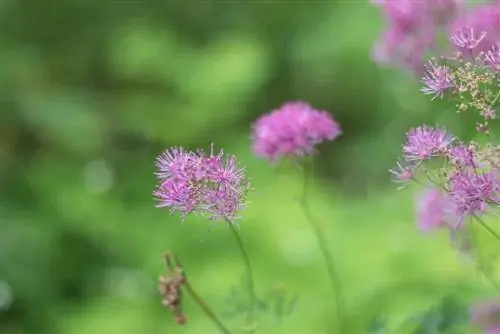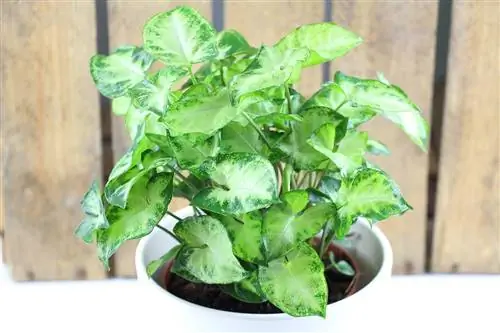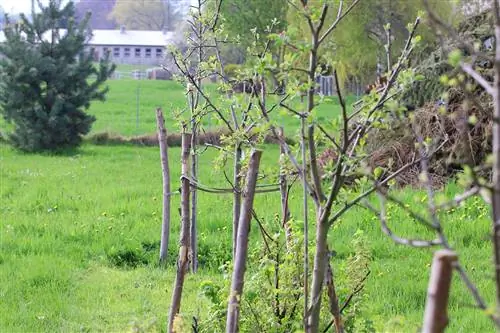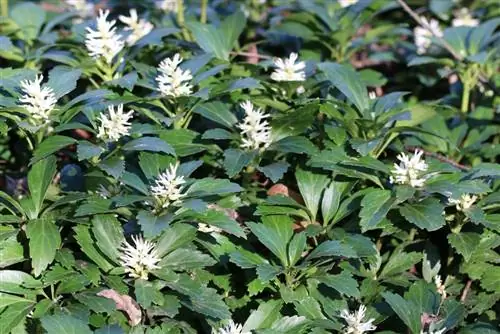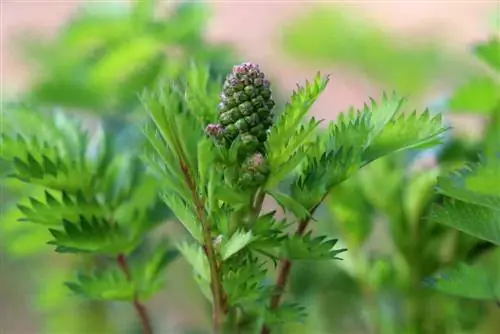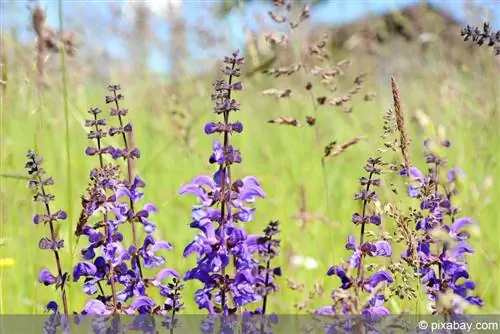- Author admin [email protected].
- Public 2023-12-17 03:39.
- Last modified 2025-06-01 06:48.
With its fine and light inflorescences, the meadow rue (Thalictrum) is one of the accent beauties in the garden bed. Its inflorescences are fine and its foliage also appears very delicate. This picturesque naturalness is its strength and also makes it interesting as a cut flower. Their airy, light flowers are a touching eye-catcher on the expanse between heaven and earth. They appear airy and picturesque, both in the garden and in the vase.
General
The meadow rue with its many species is one of the fragile and delicate perennials. Its leaves are fern-like and its flowers have a pleasantly natural effect. In the perennial bed, they form an expressive and wonderful contrast next to the clear shapes of refined perennials. They bring a natural lightness to the beds. The meadow rue genus includes more than 100 species. Of these, around 13 species grow in Europe. Many of them are suitable for planting in the garden, whether as border perennials, giant perennials or very delicate dwarf perennials. The meadow rue probably got its name because its leaves are somewhat reminiscent of those of a rue (Ruta).
The petals of the meadow rue fall off early. They also do not secrete nectar. This task has been taken over by their fragrant and colorful stamens. They richly reward the flies and beetles, which are important for pollination, with their pollen. However, the meadow rue also offers a very good example of evolutionary development. Because here flower pollination by insects changes to pollination by the wind. At first glance, evolution seems to be going backwards here. But appearances are deceptive, because these types of pollination favor and ensure the viability of the meadow rue.
Meadow rue with its many species should not be missing from any perennial bed. The small meadow rue remains small, picturesque and is ideal for loose planting in borders or as a natural border in front of trees. The Hohe Wiesenrute easily reaches two or more meters. It is also impossible to miss in borders between bluebells, chivalry and silver candles.
The most popular species
- Thalictrum aquilegifolium is the columbine meadow rue. It looks very delicate and yet is very robust. It grows slowly and clumpily. Its flowers look rosy and very fluffy.
- Thalictrum aquilegifolium 'Album' is a white-flowering variant of the columbine-leaved meadow rue.
- Thalictrum delavayi, China meadow rue, comes from China. Its flower spikes are curved and densely decorated with delicate bell stars. Their delicate violet appearance is expressively supported by their cream-colored stamens. Don't plant too close together.
- Thalictrum delavayi 'Album' is the pure white flowering form of the meadow rue from China. She enchants with a very personal charm.
- Thalictrum delavayi Hewitt's Double, double meadow rue, has double and very long-lasting flowers. It is a little reminiscent of gypsophila in pink to purple. A wonderful garden perennial.
- Thalictrum delavayi ssp. Decorum is very similar to Thalictrum delavayi, which comes from China. However, it is a little bigger and gets a little higher.
- Thalictrum rochebrunianum, high meadow rue, is a giant among the meadow rue species. It can grow over 2 meters high and still remains completely stable. However, because of its delicate flowers and fern-like leaves, it does not appear bulky at all. A lovely background or specimen perennial.
- Thalictrum minus - Small meadow rue, likes to grow between bushes on river banks and riparian meadows. It is popular as an ornamental plant and is released into the wild in meadows. In Finland the subspecies ssp. Kemense is threatened and is a protected species.
- Thalictrum simplex, simple meadow rue, likes to grow on the edges of forests, in deciduous forests, on meadows, on bank slopes and flood meadows, on dry meadows and on roadsides.
Origin
The columbine meadow rue, the yellow meadow rue, the Alpine meadow rue, the shiny meadow rue, the small and high meadow rue, among others, come from Europe. The Thalictrum delavayi, the Chinese meadow rue, comes from China. All species are now at home all over the world.
Location
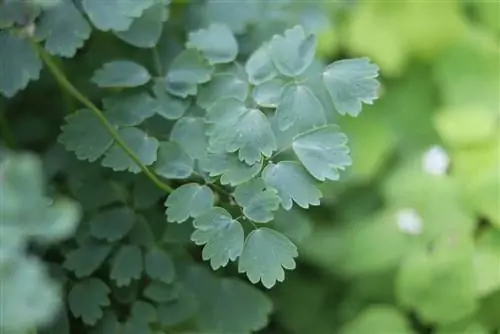
All meadow rue love a sunny to partially shaded location, ideally with an interplay between light and shade. Since the soil should be slightly moist, it thrives particularly well near a pond or in the shade of loosely planted trees.
Plants in the flower border
The meadow rue develops its beauty and natural effect particularly intensively in a border in the plant community with
- white Germer
- Troll Flowers
- clear blue ladder to heaven
- white meadow daisies
- green-yellow lady's mantle
- Meadow knotweed with its reddish candles
- Funnel fern
- Meadow Cranesbill
Substrate
The meadow rue loves it moist, but cannot tolerate standing moisture. The soil should only be moderately moist, acidic to slightly acidic, humic and permeable.
Planting spacing
For the optimal development of the individual plants, the ideal planting distance is 40 to 50 centimeters.
Pouring
Meadow rue requires soil that is always slightly moist. This makes regular watering necessary. If the soil is too dry, this will inevitably lead to the rapid death of the plant. If the soil is too wet, the plant will rot.
Fertilize
Annual fertilization with a high-quality compost brings very good results. Calculate 1 to 2 liters per square meter so that the meadow rue thrives vigorously and produces rich flowers.
Tip:
To prevent the wind from knocking over tall meadow rue, tie the stems to support rods.
Cutting
After flowering, the meadow rue can be cut back thoroughly. The plant then sprouts again quickly and forms new clumps of leaves.
In late autumn, all above-ground parts of the meadow rue die off and can easily be removed.
Wintering
The meadow rue is absolutely frost hardy and survives the winter without further winter protection.
Propagation
Propagation takes place in spring by dividing the perennial or by sowing. The seeds of different varieties are available in specialist shops, but the meadow rue also sows itself.
Tip:
Rejuvenation after 3 to 5 years is good for the plant. Take the 'old' plant out of the bed in spring, divide it and put the strong sections back into the bed.
Diseases and pests
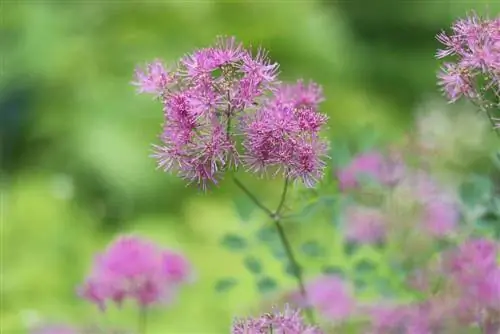
Diseases and pests are rare and therefore hardly known. However, meadow rue occasionally suffer from powdery mildew and leaf miners (very small fly larvae that feed on the plant juices in the leaves). A radical pruning after flowering can help.
Frequently asked questions
How much sun can my meadow rue tolerate?
The wetter the soil is at the planting site, the sunnier the meadow rue can be.
What can I do so that the meadow rue doesn't look so unsightly after flowering?
After flowering, simply cut the plant back to the ground. It then sprouts again beautifully.
What you should know about the meadow rue in brief
Meadow rue are pretty to look at and easy to care for. They are often used as cut flowers. There are two flower shapes: flowers that are reminiscent of small clematis flowers and flowers that are reduced to stamens, quite large and very numerous.
Location
sunny to partially shaded location
Planting substrate
- permeable
- sour to slightly sour
- fresh earth
- humos
- Planting distance 40 to 50 cm
Watering and fertilizing
- Since the ideal soil should always be slightly moist, watering must be carried out regularly.
- Fertilize with compost 1 to 2 l/m²
Cutting
- cut back completely after flowering, then new clumps of leaves will sprout
- The plant dies above ground in late autumn
- then remove remains
Wintering
fully frost hardy, even without winter protection
Propagate
- Division and sowing, both in spring
- sows itself
Diseases and pests
- Diseases and pests are rare
- soil that is too dry leads to the rapid death of the plant
Chinese Meadow Rue
The Chinese meadow rue is a very beautiful variety. The special feature is the decorative flowers. They are available in the flower colors white, beige, cream, purple and pink. These plants like a partially shady location or light shade. The soil should be fresh, acidic, sandy-clayey, fertile and medium dry. It is important to water sufficiently (no standing moisture). Otherwise, this meadow rue is quite frugal. Older plants die off, so grow new plants in good time.

